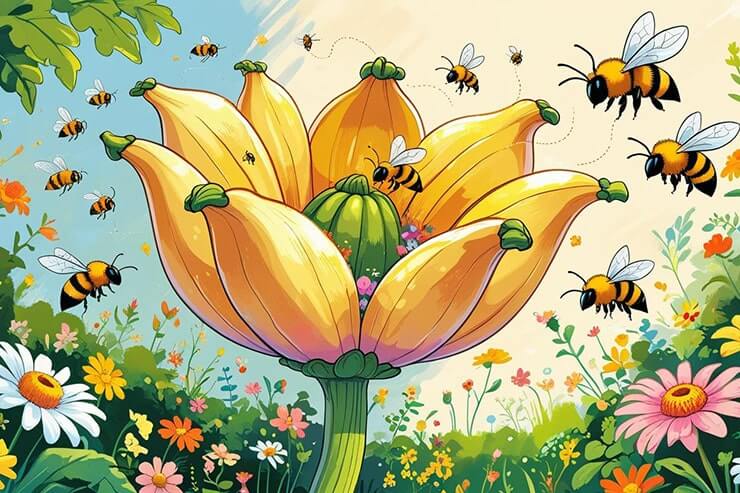Read by Matilda Longbottom

Nearly every plant in the garden reveals evidence of bees. Honeybees, long-horned bees, and cranky wasps walk across the faces of sunflowers. Semicircle-shaped holes in leaves indicate that a leafcutter bee built a nest nearby. Later, I watch her wiggle her bottom, collecting pollen from sweet peas in the hair that lines the underside of her torso. A drone like a tiny, low-flying airplane alerts me to a giant bumblebee landing in the bergamot. Sleek, black carpenter bees congregate on the tassels that will become ears of corn. Amidst all this activity, the squash bee alone remains dedicated to a single flower.
At first glance, the squash bee looks like a honeybee, but with a fuzzier thorax, flatter abdomen, and more compact black-and-yellow stripes compared to the varieties of golden bands honeybees sport. Unlike many pollinators, squash bees are specialists, adapted to a particular type of plant, the genus Cucurbita—squash.
I am also well acquainted with squash blossoms. The first year I planted pumpkins, my garden produced just one vine, which I watched with anxious hope. The following year, I researched pollination, trying to uncover why my efforts the previous Summer produced a single, tiny pumpkin. Looking at squash blossoms, I saw sex and reproduction in the most clinical fashion. The yellow, star-shaped flowers open to long anthers covered in pollen or to a round stigma ready to receive that pollen, allowing the ovary at the blossom’s base to develop fruit. Technical, easy to diagram, even a novice gardener can hand-pollinate a squash blossom with little effort.
Inspired by my studies, I got carried away with the garden catalog, determined to grow a wagonload of decorative squash. I fertilized the soil with “beans” from our small alpaca herd, and my pumpkin patch developed an enormous tangle of vines from nine types of Winter and Summer squash seeds. One morning, while watering, I heard a low, angry buzz and peeked into a squash blossom weighed down by the hose’s spray. The big eyes and long antennae of a resting squash bee greeted me.
Preoccupied with fertilization, my research missed that a squash blossom is itself food, and, sometimes, a hammock. Pollinators provide the movement that makes pumpkin sex possible, and the squash bee has evolved a special romance with these blooms, the rhythms of their activity aligned so well with those of the flowers that they usually beat other bee species to the pollen and nectar. Bee and blossom engage in a dance, the flowers opening in the morning for female squash bees to forage for pollen and nectar while males search for mates, pollinating as they do so. By noon, the flowers close, and the hum of the squash bees gives way to the activity of other insects. Once squash bees discovered my garden, I never fretted about pollination again. I was thankful for the abundance of pumpkins, but the sweet faces of the squash bees resting in the flowers drew me to the pumpkin patch each morning to investigate their work.
Like a child finding a fairy house inside the knot of a tree, I approach the pumpkin patch on Summer mornings, hoping to see squash bees, nestled together, resting from their work. The blossoms cradle them, petals curling in protection around these favorite visitors. Occasionally, a sleepy squash bee will stick its head out, rubbing antennae together, as though stretching from a long slumber. He watches impatient honeybees flit around, searching for unoccupied flowers. By Autumn, the female squash bees will be tucked away in solitary underground dens nearby, the fattening pumpkins the only hint of the work they did all Summer. ❖
About the Author: Kasey Butcher Santana is a writer and caretaker of a small alpaca farm where she and her husband also raise chickens, bees, and their daughter. Recently, her work appeared in Pithead Chapel, Split Lip, Superstition Review, Write or Die, and Passengers. You can follow her on Instagram @solhomestead or at Life Among the Alpacas on Substack.


 Previous
Previous

